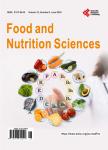The Antioxidant and Free Radical Scavenging Activities of Chlorophylls and Pheophytins
The Antioxidant and Free Radical Scavenging Activities of Chlorophylls and Pheophytins作者机构:Biodiversity Research Center Academia Sinica Taipei Taiwan Department of Food and Nutrition Chinese Culture University Taipei Taiwan Department of Nutrition and Health Sciences Chang Gung University of Science and Technology Taoyuan Taiwan School of Nutrition and Health Science Taipei Medical University Taipei Taiwan
出 版 物:《Food and Nutrition Sciences》 (食品与营养科学(英文))
年 卷 期:2013年第4卷第8期
页 面:1-8页
学科分类:1002[医学-临床医学] 100214[医学-肿瘤学] 10[医学]
主 题:Chlorophyll Pheophytin Comet Assay Antioxidation
摘 要:Chlorophylls are important antioxidants found in foods. We explored the mechanisms through which the a and b forms of chlorophyll and of pheophytin (the Mg-chelated form of chlorophyll) reduce oxidation: we used comet assay to measure prevention of H2O2 DNA damage;we tested for quenching of 1,1-diphenyl-2-picrylhydrazyl (DPPH);we measured the ability to chelate Fe(II);and, we tested their ability to prevent formation of thiobarbituric acid reactive substances (TBARS) during Cu-mediated peroxidation of low density lipoprotein (LDL) in a chemical assay. All chlorophylls and pheophytins showed significant dose-dependent activity in the assays, with the pheophytins being the strongest antioxidants. Thus, these chemicals can prevent oxidative DNA damage and lipid peroxidation both by reducing reactive oxygen species, such as DPPH, and by chelation of metal ions, such as Fe(II), which can form reactive oxygen species.



